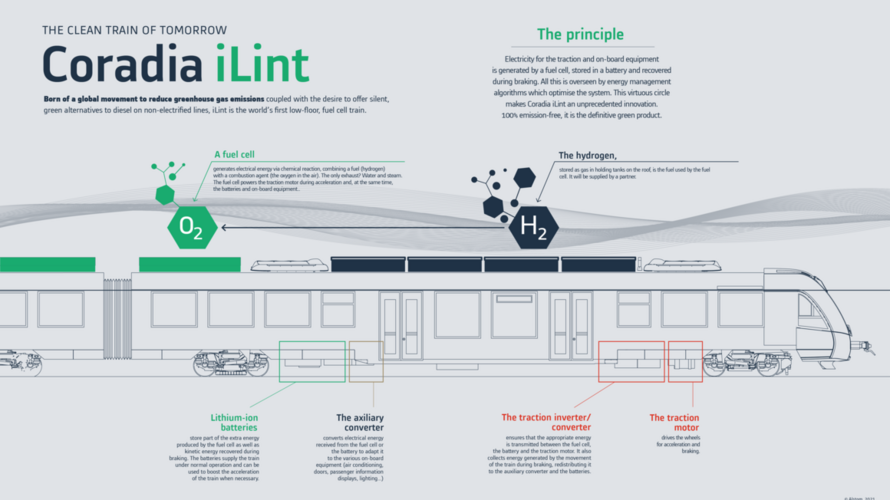
Fleet of hydrogen passenger trains begins service in Germany
German officials have launched what they say is the world’s first fleet of hydrogen-powered passenger trains

Hydrogen tanks on the train car roofs. These are fairly compact passenger trains -- every picture I see suggests 2-car units.I wonder how they do carry their H2. Is that in a tank mounted on a carriage the old way coal was tracted by steam locomotives? 1000km of range would suggest quite a volume for the power needed (I didn't do the calculation).
Anyway, that's plain cool. Congrats to all involved.


I suspect quite a lot of hydrogen is shipped by rail already, and the amount on the new hydrogen-fueled locomotives would not markedly increase the amount of hydrogen vented near power lines@TomS : Thanks for the links.
In the last, the author seems to be carried away by his own opinion forgetting that non-electrified residual networks exist because of structural constraints. Mainly cost of infrastructure versus the imperatives to deliver railway services to local population. Hence, you can't clear away those realities just by saying that electrification is the only key. (who would pay for that? Who would maintain the lines? Pay for the extra workers needed when this ha snot been deemed economically feasible for decades?...).
However, those trains generally cross more classic electrified lines when they cross-path another railway line or enter a connecting station. I am a little bit dubious with the roof mounted tanks and the risk of H2 venting close to high power lines. I hope those tanks are immerged inside a neutralizing solution (ionized water?) or anything that would shield from any pemeating hydrogen.
. I am a little bit dubious with the roof mounted tanks and the risk of H2 venting close to high power lines.
Probably a lot like this:And even if it did burn, it would just burn upward, away from the train and passengers.
Grossly misleading postHydrogen is an evil genie that always manages to escape from the bottle, always.
Grossly misleading postHydrogen is an evil genie that always manages to escape from the bottle, always.
The misleading aspect is to post images of the Hindenburg or nuclear explosions in a post talking about Hydrogen powered buses. There is no way one is going to see anything even mildly like that.Grossly misleading postHydrogen is an evil genie that always manages to escape from the bottle, always.
This is not my personal opinion, it is an absolute physical truth: the hydrogen atom is smaller than those of any other element. It will always escape from any container, and when it does... KABOUM!!
Is this a joke?Hydrogen is an evil genie that always manages to escape from the bottle, always.
Politicians follow the same cycle in their annual speeches since the early seventies: alternative fuels, social issues, travel to Mars, peace in the world, alternative fuels...The Issue with hydrogen it expensive !
It Production and Storage cost more and consume more energy like for Methan.
it reacts happy with other materials, it seep into them make them brittle like tanks or pipelines
and ones it escape... KABOUM!!!
For moment the Politicians jumping on this bandwagon as solution for everything,
but after some years of high cost, issues with infrastructure maintenance and disasters, they abandon it...
